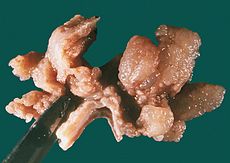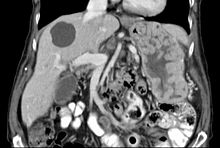- Ménétrier's disease
-
Ménétrier's disease Classification and external resources 
Ménétrier's disease. In this case, there was so much pit hyperplasia that the giant folds appeared to be covered by a myriad of polyps resembling hyperplastic polyps. The muscularis propria is the folded structure at the bottom center.ICD-10 K29.6 ICD-9 535.2 OMIM 137280 DiseasesDB 8001 MeSH D005758 Ménétrier disease (also known as hyperplastic hypersecretory gastropathy, and named after a French physician Pierre Eugène Ménétrier, 1859–1935), a disorder in which the gastric mucosal folds (rugae) are enlarged[1] (and the total weight of the stomach is increased), making the surface of the stomach look a bit like the brain gyri. This leads to protein loss, parietal cell atrophy, and an increase in mucous cells. It results from profound hyperplasia of the surface mucous cells with accompanying glandular atrophy.
Contents
Presentation
The altered gastric mucosa secretes massive amounts of mucus, resulting in low plasma protein levels. The tissue may be inflamed and may contain ulcers. The disease also causes glands in the stomach to waste away and causes the body to lose fluid containing the protein albumin.There are two forms of the disease: a childhood form and an adult form. The childhood form has a better prognosis. It affects males three times more than females, most often after they have a viral illness caused by cytomegalovirus (CMV) or a bacterial infection caused by Helicobacter pylori. Children are not born with this disease, and it is not passed from parents to their children.[2] The adult form is linked with overexpression of transforming growth factor alpha (TGF-α). The adult variety is four times more common in men, primarily affecting men between ages 30 and 60.
Symptoms
The presenting symptoms are:
- Epigastric Pain - pain after the meal (postprandial), relieved by antacids, is very usual
- weight loss, cachexia
- peripheral edema, ascites
- anemia symptoms secondary to blood loss
Ménétrier disease increases a person's risk of stomach cancer.[3] Microscopically, the disease is characterized by hyperplasia of the crypts, which are elongated and may appear cystic or corkscrew-like.
Since it predisposes to stomach cancer, periodic endoscopic surveillance is mandated. CMV-related Ménétrier is often self-limited.
Diagnosis
The disease maybe diagnosed by x-ray or endoscopy and biopsy of the stomach.
Treatment
In adults, there is no FDA approved treatment other than gastrectomy and a high-protein diet. Part or all of the stomach may need to be removed if the disease is severe. However, the monoclonal antibody cetuximab has been used in compassionate use for treatment of Ménétrier's disease[4] .
Pediatric cases are normally treated for symptoms with the disease clearing up in weeks to months.
Related conditions
Other forms of hyperplastic gastropathy include Zollinger-Ellison syndrome.
References
- ^ http://www.gpnotebook.co.uk/cache/-2026569705.htm
- ^ http://www.madisonsfoundation.org/content/3/1/display.asp?did=413
- ^ Menetrier's Disease: symptoms, cause, treatment, prevention, long-term outlook, complication, risks
- ^ "Error: no
|title=specified when using {{Cite web}}". Treatment of Ménétrier's Disease with a Monoclonal Antibody against the Epidermal Growth Factor Receptor. http://www.nejm.org/doi/full/10.1056/NEJM200012073432305.
Categories:- Stomach disorders
Wikimedia Foundation. 2010.

